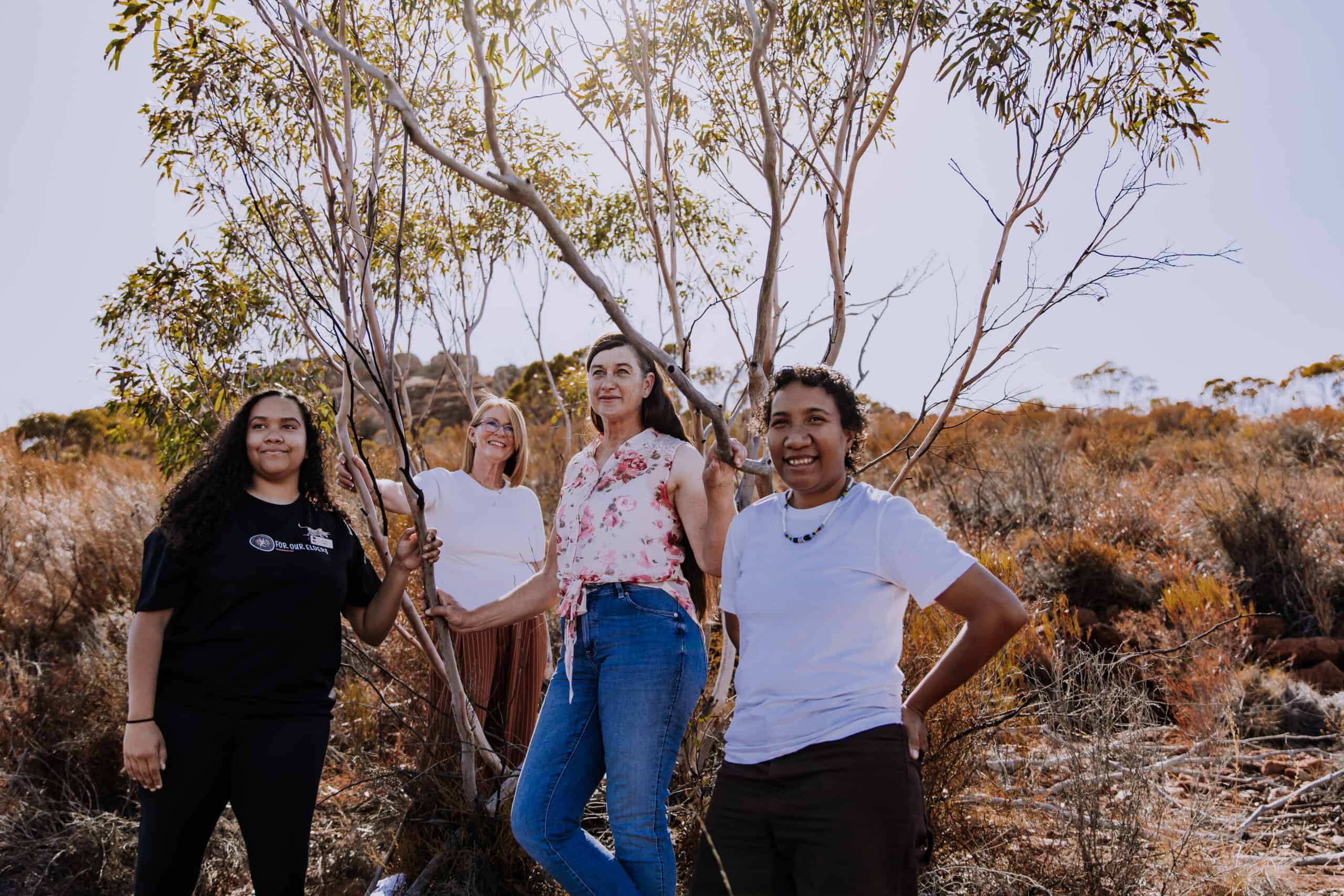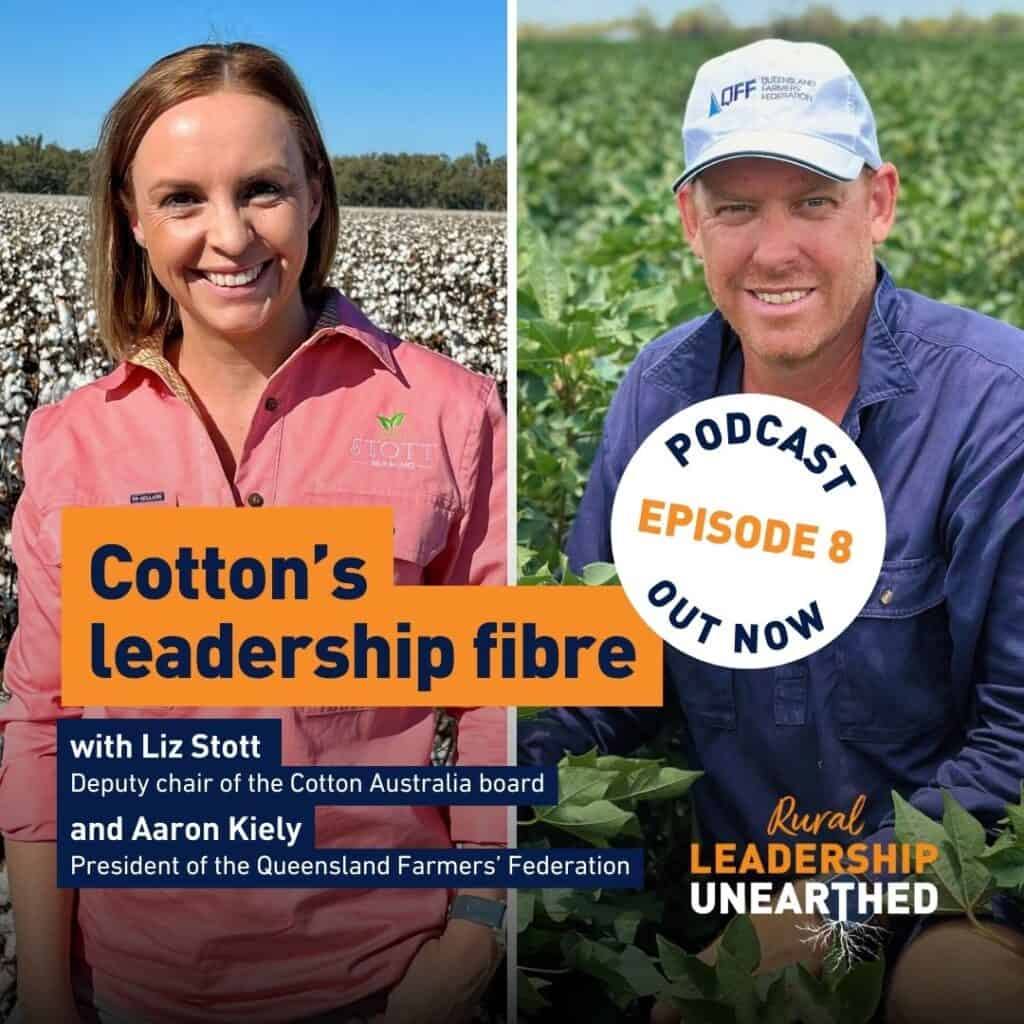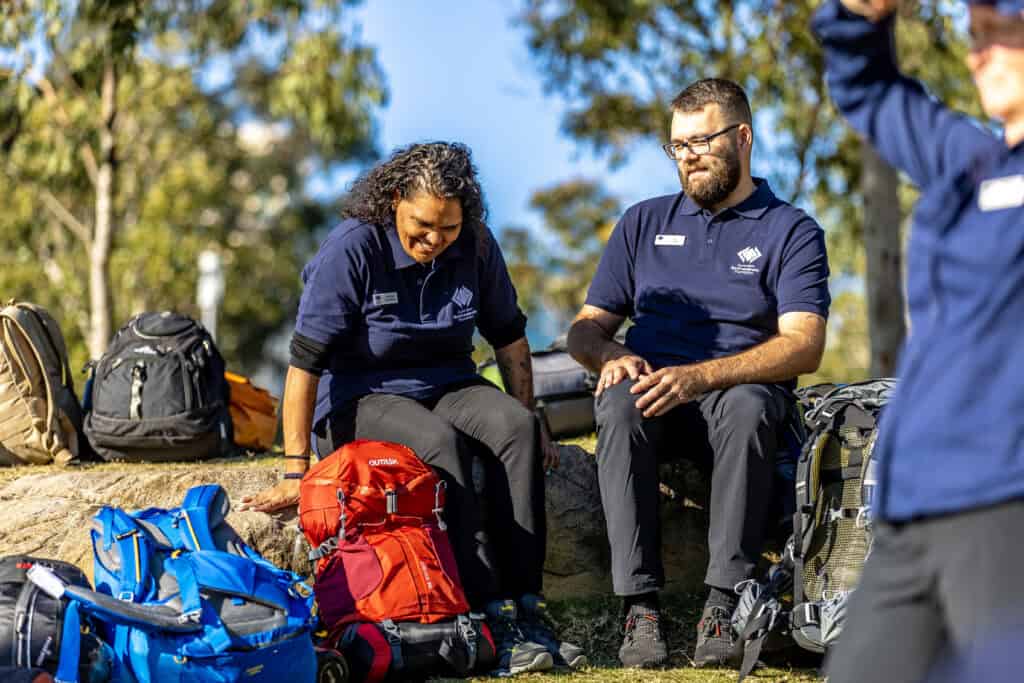It is early in the day, but already the sun has a bite that is a portend to the savage heat that lies ahead on a February day in Western Australia’s Goldfields region.
Piercing rays create shadows on Mount Jimberlana’s rough granite edges, highlighting cracks on its aged facade. Described as one of the oldest geological formations in the world, it is logical that this landmark would be important to the Ngadju First Nations people who have known it for a long time.
From it, the view reveals the region’s identity and the physical parameters that defines Goldfields’ life. Vast distances between people and services that sustain them; mineral wealth that powers a boom-and-bust economy; dry and hot, and bitterly cold…and landscapes that keep people in place despite any discomfort created.
On this day, one on which the mercury hovered at 41.4o celsius, there is a group of women stealthily picking their way up the side of Mt. Jimberlana. They laugh and chat as they go, the bond between them obvious.
Tracey Rathbone, Laurene Bonza, Nicolie Thomas and Heather Momo are graduates of the Australian Government funded Leading Australian Resilient Communities (LARC) program delivered by Leadership WA in partnership with the Australian Rural Leadership Foundation and Regional Australia Institute.
They travelled to Mt. Jimberlana after meeting with photographer Rosie Henderson at the BP service station, 726 kilometres east of Perth. It is at the junction of roads leading to Kalgoorlie-Boulder and Kambalda, Coolgardie and Esperance.
They are on a mission to tell the story of their leadership journeys, individual pathways that have culminated in a shared quest to enrich the lives of the young in the Goldfield-Esperance region. And they are keen to chat about the Community Connectivity Youth project that has evolved from their LARC experience.
A quick coffee, a chat and on to Mount Jimberlana, chosen for the gathering because of the story told by the landscape. This is the nature of place that they love, one that poses challenges to its inhabitants.
Here, outback Australia is gritty…and stunningly beautiful. It is the inspiring environment and respect for people that live in it that animates this group of LARC graduates. It is hard to imagine these women did not know each other before the program.
Distance no barrier to bond between new friends
When the climb is too much for Nicolie, who’s nursing a knee injury, Tracey remains behind rather than pushing to greater heights. Because that is what the group is like. There are no egos getting in the way of action and cooperation, instead there is shared leadership strengthened by a supportive bond. As Tracey says, LARC showed them that they could be effective leaders and remain true to themselves.
And as we wind our way upwards, the lively conversation reveals a great deal about what leadership and community means. Tracey has lived in the Goldfields for 40 years of her life, Kambalda is the family home; Heather moved to Mount Margaret from Papua New Guinea to take up a role as a youth worker; Nicolie is proud to be a First Nations person with family roots in Esperance, Norseman, and in the lands; and Laurene says she ended up out among the granite and salt flats because of “poverty and a broken heart”.
Their origins and reasons for being here reflect their community’s innate diversity. LARC brought them together. Though they already shared their geographical space, all but Tracey and Laurene were strangers to one another.
Nicolie was 19 years old when she walked into the LARC forum…intimidated by the leadership presence in the room. Heather knew no one, but when the two found each other seated at the same table, their common interests ensured they gelled straight away, and it is hard to imagine that they have not been lifelong friends.
Tracey and Laurene knew one another through their roles on the Coolgardie and Dundas Shire Councils but the LARC group’s shared commitment to community drew them closer. All four now focus as a team working to bring to life the Community Connectivity Youth project, an idea generated during the LARC program.

Connecting youth across the Golden Outback
It is a project aimed at making life better for young people in the region through opportunities and improving their engagement with each other and their communities. Limited transport options restricted access to activities away from home, so the group’s LARC project revolves around the introduction of a sponsored bus service. They believe such a service would benefit and improve community outcomes for young people between the ages of 12 and 17 by expanding the range of opportunities available to them.
Walking upwards, with red dirt underfoot and eucalypt trees providing occasional cool spots of shade, Tracey and Laurene speak of their experiences with local government. They chat about their desire to improve life in the region for young people, who are the future of their communities.
Her commitment to community has led to Tracey serving as Coolgardie Shire Council deputy president. She describes herself as being “…passionate about unlocking the strengths of community participation and the contribution all can make to community health, wellbeing, and growth”. Her experience as a life skills coach means she’s aware of the long-term impact of society’s treatment of young people.
“I see the youth justice is being tackled wrongly. The system is failing young people. They are being left without direction,” she explains.
Lacking in discipline, direction, option and mentorship, young people were not being offered positive pathways in life.
“We need to take a different approach; avoid detention, but do something positive,” Tracey says.
As a customer service officer with WA Police and in her capacity as the Dundas Shire Council president, Laurene views her community through varied lenses, and sees so clearly that young people have been let down.
She says it would be great to see them being encouraged to “build” something.
“They simply do not have the guidelines or mentorship to help them make beneficial life choices.”
Laurene’s commitment to better outcomes for her community includes its young citizens. And the LARC project.
Tracey says the bus service would enable young people to feel safe as they travel to events, participate in projects, and get to appointments.
“The service will give them the opportunity to discover and learn, despite the size of the region.”
Spinifex surrounds Nicolie as she talks of her desire to use the bus to get the young people out of Esperance, where they are too comfortable, with access to internet and modern trappings.
In her Mudjar Aboriginal Corporation youth assistant role, she’s already able to have an impact, describing herself as a “big sister” to the younger members of her community.
And as a proud Wudjari Nyungar, Ngadju and Wongi woman from Esperance up to the Ngaanyatjarra lands, Nicolie is keen to get young people out of their comfort zone and onto Country where they can connect with the land and gain strength.
“I want to get them out onto the lands, to smell, feel and learn it.”
Using LARC leadership learnings to help local youth
She says LARC has helped her on her path to contributing to community.
“I have always wanted to give back to community. Through LARC, I learned that you don’t have to be that dominant leader, you can be one who supports and guides others.”
Working on the bus project with the group has enabled her to work in a positive way on an issue she cares about.
“I am concerned about the youth; truancy, run-ins with police…” Nicolie says. “It makes me sad seeing the youth without a connection to their lands, and I think the bus will help with that.”
Heather agrees wholeheartedly. While the bus may physically connect people with distant places, time spent on the bus would enable them to develop relationships with others.
“We can use the bus to connect people with places, and other people,” Heather explains.
“There is nothing quite like a good road trip.”
She speaks as someone with years of experience in youth work. After working in her homeland of Papua New Guinea as a youth worker, she brought her experience to a similar role at Mount Margaret in the Goldfields.
It was a dramatic change from a life surrounded by jungle, with easy access to the sea and fishing. But she has embraced life in inland Western Australia and her passion for youth work is infectious, with her energetic nature enlivening the conversation as it turns from her past to her present, and the young people she cares about so much.
As a youth worker with the Goldfields YMCA, Heather is acutely aware of the impact of drugs, alcohol, violence: all were negatives that could be countered by effective programs and policies.
“We need to take steps to change the situation.”
Heather says that while sports had once been a point of focus in regional communities, there was a strong arts community in the lands where she worked.
“The bus will connect that, taking people out to draw and sketch, or travel to art exhibitions,” she says.
All aboard…once a sponsor’s onboard
The vehicle would enable communities to take ownership of their lives and interests, and give them mobility.
The group has thought hard about how to make the bus service a reality, and has consulted with key community members and groups, First Nations people and young stakeholders to make sure it’s worthwhile. A formal proposal and business case are complete, and the YMCA is onboard to help with coordinating the service and bookings. Various local groups and organisations, including local government bodies, a leadership organisation, high schools, and Aboriginal corporations have provided written endorsements and support.
As a network of support unfolds, the quest is to secure funding from companies operating in the area, large corporates mindful of their need to shore up their social licence to operate and fulfil their responsibilities to the communities they operate in.
“The bus project is an ideal community project: they’d have a MOU to sign, and their logo and branding would be promoted in the bus,” Tracey explains.
While an all-terrain vehicle would be perfectly suited to the country, the group has its sights set on the more financially feasible goal of a two-wheel drive option.
Accessing opportunities across the vast landscape
Penning words of support for the LARC graduate’s project, Golden You Leadership founder Meghan Kent says she was pleased to learn the group was dedicated to promoting inclusivity among youth, “…recognising the importance of removing barriers to their participation”.
She says every young person deserved equal access to educational and recreational opportunities, regardless of their socio-economic background or physical abilities.
“This initiative will create opportunities for youth from various backgrounds and abilities to come together, fostering a sense of inclusivity and collaboration.”

Weeks after the journey to Norseman, Nicolie is in Esperance. She has gathered young people and parents to chat about the importance of providing spaces that allow youngsters to be absorbed in healthy and positive activities, like basketball and surf-life saving.
Oisin (15) and Niamh (12) Murphy play basketball. Both are Esperance Breakers Talent Development Squad and Esperance Goldfields Surf Life Saving Club members. They spend time training, on the court and in the water, and their mum, Kara, says the family spends hours on the road. Especially when there are commitments far from home. Now living in Esperance, the family used to live 100km further east at Condingup, an extra hour further than the standard seven-hour journey to Perth events.
While journeys away exposed Esperance players to various levels of competition, and demanded skill development, they also allowed interactions with people from different areas of the state. Through journeys to places like Broome for surf lifesaving, both Oisin and Niamh made friends and broadened their networks.
When asked what they would be doing without such a focus, Niamh was quick to say, “I would be on my phone”. Oisin, on the other hand, would be playing a farming simulator game…but still inside.
And while young people may find it hard to pinpoint the benefits of activities like sport and the arts, away games and cultural activities, Kara was acutely aware of the benefits of easier access to transport.
“Sport provides young people with a sense of community and belonging,” she says.
By offering an option for those who could not easily travel to events away from home, a youth bus would open doors for youngsters otherwise unable to take part. Jaymes Wynne (15) and his mother, Andrea Wynne, join the chat and speak of the hours spent on the road to get to training and competitions that are part of Jaymes’ commitment to sport.
Jaymes, who’s a member of three basketball squads and plays football, agreed his sporting activities kept him occupied in a positive way, while providing him with the chance to interact with people from different areas of the State. But such exposure comes at a price.
“The hours spent travelling have an impact on families, and if we didn’t have the distance barrier, there would be more opportunities,” Andrea says.
She adds that she felt for the young people who missed taking part in activities due to the financial and logistical difficulties associated with travel.
“We would like to do more things with clubs in Kalgoorlie, but we don’t get that chance.”

The group of youngsters grows when we arrive at a place with a basketball hoop. Josh Clements (15) joins his teammates; they slip into their Breakers shirts and start throwing and bouncing the ball. No longer quiet and reserved, the thud of the ball on the bitumen court is lively, and their faces are bright with the joy that comes from play. Especially with friends. As Josh says, sport is important because of the friendships made. And even though he says he “loves” living in Esperance, because it is where his mates are, there are limits to the entertainment options.
“There is nothing else to do around Esperance,” Josh says.
Sport fills a gap for him. The bus would fill that gap for even more young people, giving them the chance to travel with others and enjoy the bonding adventure that only a bus journey can provide.
It would be a sensible travel alternative for families driving long distances following events, sporting and otherwise, far from home, when fatigue becomes a real safety issue.
By working so hard to improve the fortunes of the younger people in their community, those who, as Laurene says, are their future, the LARC graduates are already having an impact on the resilience of their remote and ruggedly inspiring place. They have instigated and fostered a discussion about the young they have responsibility for and looked at those future leaders in the context of place.
And worked together among the granite boulders and salt lakes, and by the sea, to find a way to navigate the distances between them, dissipating boundaries and unlocking better roads to follow.
The Leading Australian Resilient Communities program (LARC) is a pilot program funded by the Australian Government’s $5 million Building Resilient Regional Leaders Initiative, with the aim of supporting regional communities to meet challenges and collectively drive community resilience.








